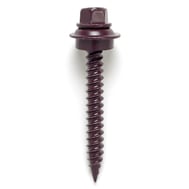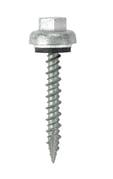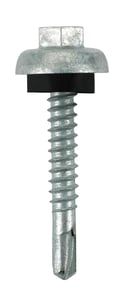What are metal roofing screws and how are they used?
Metal roofing screws are the means by which metal panels are attached to the building structure, whether steel or wood substrates. They are available in many sizes, designs, and materials each specifically designed for various applications and the end result desired by the builder and building owner.
What are metal roofing screws made of?

The fasteners are made of various metals and combinations of metals all to achieve different results. The standard fasteners are a carbon steel base with plating or coating to provide some level of corrosion resistance. For the optimum protection against corrosion, Long Life fasteners should be used. These are stainless steel and ideal for aluminum panel attachment. Generally, an all stainless screw does not consistently pierce or drill a steel panel on its own. For steel panel attachment where complete corrosion resistance is required, a bimetallic fastener would be the option. Bimet fasteners are available for both wood and steel structure applications. The head and shank of these fasteners are stainless with a carbon steel point that allows the fastener to penetrate a steel panel and drill into both wood or steel substrates.
Why you should choose screws vs. nails when installing a metal roof - what are the benefits of metal screws?
Originally many years ago metal panels were attached to post-frame structures (referred to as pole barns at the time) with nails. This evolved into nails with washers to provide some degree of weather tightness. As installers looked to improve both the holding power and weather tightness of the attachment, threaded fasteners with sealing washers were developed specifically for panel to wood applications. Over the years the designs have improved to maximize the benefits - ease and speed of installation, holding power, pullout values, corrosion resistance, and aesthetics, to name a few. By using a proper screw gun (2500 rpm) the screws can be installed faster than hammering nails and with better control over the finished result - proper depth setting and improved sealing against water penetration. The holding power or pullout strength of screws is substantially higher than any nails. Additionally, screws can be easily backed out if the need arises, a task not so simple with nails.
How many metal roofing screws will a typical roof use?
The number of fasteners on any metal panel roof is dependent upon several factors - panel profile, purlin spacing, as specified by the panel manufacturer. Generally, fasteners are installed on one side of each rib in the flat and on every purlin, typically 2' OC on a roof. At the roof ends or eaves, fasteners are often installed on both sides of the ribs. Additionally, sometimes the side laps are stitched as well by installing fasteners in the ribs where the panels overlap.
How long do metal roofing screws last?

On standard market carbon steel fasteners, the life expectancy and/or time until the fasteners exhibit some form of red rust corrosion are dependent upon several factors - fastener finish, installation technique, and most importantly the environmental conditions. The proximity to coastal areas, effects of acid rain, or exposure to corrosive elements from industry or agriculture can severely diminish the resistance to corrosion. The typical structural life of a metal roofing screw designed for exterior application properly installed is the lifetime of the panel. Red rust and corrosion may occur over time due to various environmental and exterior conditions.

The next step up in terms of corrosion-resistant fasteners would be the Long Life capped fasteners whose caps cover the heads (zinc alloy or stainless). This will protect the exposed part of the fastener against red rust corrosion.
The all stainless or bimetallic fasteners are the best choice for fastening when absolute corrosion resistance is desired for the entire fastener, both on the exterior and interior of the building.
Do metal roofing screws ever need to be replaced or maintained?
Fasteners could require replacement or maintenance based on - (A) the fasteners are improperly installed which could lead to issues that would require fastener replacement (B) if the fasteners are exposed to a corrosive environment which could lead to the need for fastener replacement (C) if the building structure or panels have excessive movement this could result in fasteners requiring replacement (D) with respect to maintenance, some panel manufacturers recommend periodic washing or re-tightening of screws depending on roof condition
If the fasteners are replaced, it is recommended that the next size up in diameter and/or length should be utilized to ensure adequate holding power as it is installed into the original hole. Longer fasteners are often utilized if there is adequate remaining substrate to grab on to the thread of the longer fastener. Wider fasteners are often utilized when there is not adequate substrate material to grab on to the thread of a longer fastener. In some situations, both longer and wider may be required.
Single piece bonded screw head vs. two piece-differences in performance and cost
There are several types of sealing washers available. On standard hex washer head fasteners there are two options.
- The Control Seal is a premium washer. It is composed of a metal dome with a separate, extra thick EPDM washer underneath. The special design on the metal dome makes this washer assembly resistant to overdriving and the resulting EPDM squash out. It is slightly more expensive than a bond seal as it provides added weather resistant performance value.
- The Bond Seal washer is a metal dish with EPDM bonded to it. The bond seal is considered a more generic washer. When properly installed it will provide adequate sealing performance.
- The Sealer washer is a thick EPDM washer assembled under an integral cupped hex washer head. These are used on some capped parts as well as metal building self drillers with the special cupped head.
Long life fasteners (ZAC) why developed, how superior, warranty implications
Long Life capped fasteners were developed to provide a fastener that is warranty compatible with galvalume panels. They are also applicable where no red rust corrosion of the head is desired. Market warranties for these items are sp ecific to the manufacturer .
ecific to the manufacturer .
The ZAC warranty covers structural failure of the fastener due to red rust corrosion of the head for the life of the building
Proper screw installation tips over vs. under driven.
The selection of proper tools for the fastening of panels is critical for the ease of installation, proper watertight sealing, and the integrity of the connection. Please click here to download the guide to proper tool selection for the installation of metal screws.
Thank you to SFS Intec for their expertise and help with this article.
About McElroy Metal
Since 1963, McElroy Metal has served the construction industry with quality products and excellent customer service. The employee-owned components manufacturer is headquartered in Bossier City, La., and has 14 manufacturing facilities across the United States. Quality, service and performance have been the cornerstone of McElroy Metal’s business philosophy and have contributed to the success of the company through the years. As a preferred service provider, these values will continue to be at the forefront of McElroy Metal’s model along with a strong focus on the customer.








Comments on this article:
Scroll down to the bottom to submit a comment and join the conversation. Need help or have a question? Please contact us. Looking for a distributor or contractor? Please click here to get started.